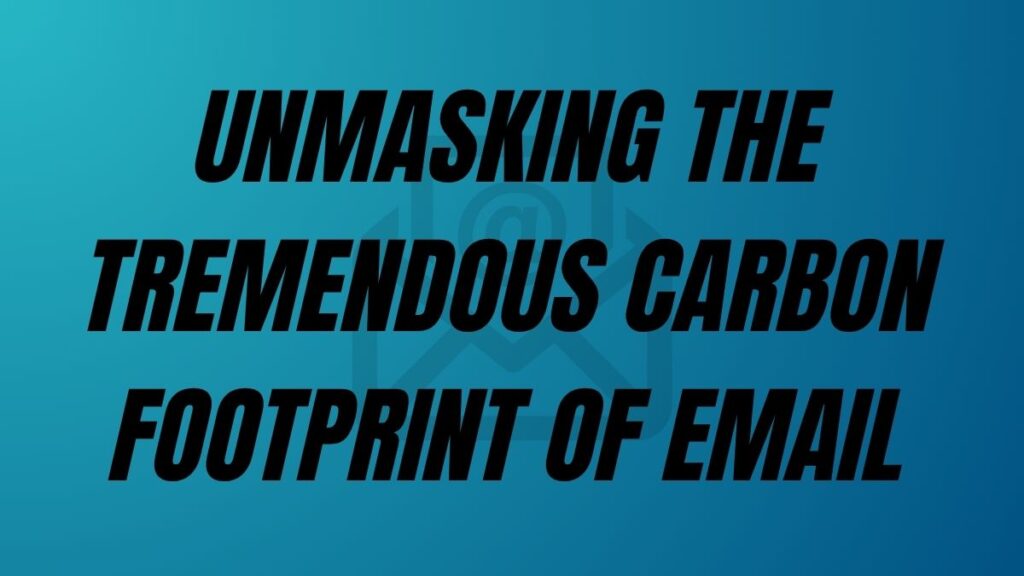In a world where technology and the environment are increasingly interconnected, digital decarbonization in business is emerging as a crucial issue. Faced with the challenges of climate change, Corporate Social Responsibility (CSR) managers are called upon to play a leading role in the adoption of sustainable strategies and lower the digital carbon footprint.
We will explore digital decarbonization, offering companies ways to understand, measure, and reduce their digital carbon footprint. In addition, we’ll highlight how to integrate these practices into corporate culture while complying with current environmental policies.
We will discuss innovative strategies and practical solutions to make digital sustainability a tangible and effective reality.
Understanding the Digital Carbon Footprint
The first step towards effective decarbonization in business is to understand the digital carbon footprint. This section demystifies the concept of digital carbon footprint, highlighting its environmental impact.
We will examine statistics on the energy consumption of data centers and networks, and discuss the carbon footprint of commonly used digital tools and technologies. This in-depth understanding is essential for developing effective footprint reduction strategies.
Defining the Digital Carbon Footprint and Its Environmental Impact
The digital carbon footprint represents the amount of greenhouse gases emitted by digital technologies. This includes the production, use, and end-of-life of digital devices and infrastructure.
Its environmental impact is significant, contributing to rising global temperatures and ecosystem change. Awareness of this footprint is crucial for guiding decarbonization strategies in business.
Understanding the Energy Consumption of Data Centers and Networks
Data centers and networks are among the largest energy consumers in the digital sector.
According to a study, data centers consume between 2 and 3% of global electricity; they could account for up to 13% of global electricity consumption by 2030.
Additionally, they are responsible for 2% of global greenhouse gas emissions.
Power Usage Effectiveness (PUE) measures energy efficiency, determining the energy required to deliver 1W to IT equipment. In France, this PUE is estimated at 1.5.
Improving energy efficiency, such as better air conditioning control, could enhance this index.
Accurate assessments of data center needs can significantly reduce energy consumption. It’s estimated that 77% of data centers are over-equipped, leading to waste.
This over-provisioning is alarming because 78% of digital technology’s environmental impact comes from infrastructure manufacturing.
Globally, digital technology accounts for between 3 and 4% of greenhouse gas emissions, which is higher than civil aviation.
Telecommunication networks are not far behind, with energy consumption also on the rise, due to the increase in data traffic, which requires increasingly large equipment. In France, networks are estimated to be responsible for 2% to 14% of our carbon footprint.
Examples of Commonly Used Digital Tools and Technologies and Their Footprint
Tools such as servers, computers, smartphones, and tablets are ubiquitous in the professional environment. Each of these devices has a carbon footprint, due to its manufacturing, use, and recycling. For example, the production of a smartphone generates about 80 kg of CO2.
Setting a Digital Carbon Footprint Reduction Strategy
After this overview of the carbon footprint of the digital sector, it is relevant to discuss strategies for reducing it.
This part of the blog focuses on methods for measuring the carbon footprint of digital tools and presents best practices for minimizing it.
From infrastructure optimization to green cloud, we will explore concrete approaches and case studies of companies that have successfully reduced their digital footprint.
Measuring the Carbon Footprint of Digital Tools
To measure the carbon footprint of digital tools, companies can use specialized software that analyzes energy consumption and associated CO2 emissions.
These tools take into account various factors, such as device usage, data center energy consumption data, and network operating modes.
The calculation of Direct and Indirect Emissions allows for the integration of all emission scopes into the carbon footprint. This includes direct emissions (scope 1), indirect emissions related to energy consumption (scope 2), and other indirect emissions (scope 3) that can come from, for example, employee travel or the manufacturing of equipment used.
A slight complexity to get a complete picture: the scope 3 of some is the result of scopes 1 and 2 for their suppliers.
Adopting Best Practices to Reduce This Footprint
To reduce the digital carbon footprint, companies can optimize their infrastructure by adopting green cloud solutions, which use renewable energy.
Other practices include improving the energy efficiency of data centers, virtualizing servers, and adopting telework policies to reduce travel.
Understanding How Large Companies Have Successfully Reduced Their Digital Footprint
Companies like Google and Microsoft have implemented effective strategies to reduce their digital carbon footprint. Google uses 100% renewable energy for its operations, while Microsoft has developed underwater data centers to reduce cooling energy consumption.
Integrating Decarbonization into the Corporate Culture
Decarbonization is not limited to the adoption of green technologies; it must be integrated into the very culture of the company. This section discusses the importance of employee engagement and sustainability training.
We will provide practical tips for integrating decarbonization practices into daily routines and discuss ways to measure and communicate decarbonization progress.
Importance of Employee Engagement and Sustainability Training
Employee engagement is essential to the success of decarbonization in business. Training and awareness of sustainable practices for employees can lead to significant changes in work habits and energy consumption.
Tips for Integrating Decarbonization Practices into Daily Routines
To integrate decarbonization into daily routines, companies can first encourage energy-efficient technologies, promote telework, and implement electronic equipment recycling policies.
Moreover, simple gestures like turning off unused devices can positively impact energy consumption. In addition, setting up a sustainable Digital Workplace is a credible path for companies looking to reduce their carbon footprint.
Through workshops and training, companies can raise employee awareness of individual and collective levers for sustainable action.
How to Measure and Communicate Decarbonization Progress
It is important to regularly measure decarbonization progress. Companies can use key performance indicators (KPIs) to track CO2 emission reductions. Communicating this progress, both internally and externally, can strengthen commitment to sustainability goals.
Choosing Innovative Technologies and Decarbonization Solutions
Technological innovation plays a key role in digital decarbonization. This part explores the latest technological innovations that help with decarbonization and presents examples of software and tools that help companies reduce their carbon footprint.
We will also look at the future prospects for decarbonization in the digital sector, highlighting the importance of continuous innovation in this area.
Presentation of the Latest Technological Innovations Helping with Decarbonization
Technological innovations play a key role in decarbonization. Advances such as artificial intelligence to optimize data center energy consumption, more efficient 5G networks, and renewable energy storage solutions are promising examples.
Examples of software and tools that help businesses reduce their carbon footprint
Energy management software, such as those that offer real-time analysis of energy consumption, helps companies identify and reduce waste. Other tools include applications for tracking CO2 emissions and collaborative platforms for remote work.
Future Prospects for Decarbonization in the Digital Sector
The future of decarbonization in the digital sector looks promising, with growing awareness and adoption of green technologies. Continuous innovation in renewable energy and energy efficiency is essential to achieve carbon neutrality goals.
Understanding the Policies and Regulations on Digital Decarbonization
Finally, it is essential to understand the regulatory and policy framework surrounding digital decarbonization. This last section provides an overview of current laws and standards and examines their impact on businesses.
We will provide practical tips for staying compliant while maximizing decarbonization efforts, highlighting the importance of regulatory compliance in a company’s overall sustainability strategy.
Overview of Current Laws and Standards on Digital Decarbonization
Several countries and regions have implemented laws and standards to encourage digital decarbonization. The European Union, for example, has adopted the “Green Deal” which includes specific objectives for the digital sector.
Examples of laws and standards in the European Union: The “Green Deal” aims to reduce EU greenhouse gas emissions by 55% by 2030 and achieve climate neutrality by 2050, the Energy Efficiency Directive (2012/27/EU) sets requirements for Member States to improve energy efficiency in all sectors, including digital and the Ecodesign Regulation (2019/1781/EU) sets energy efficiency requirements for digital products such as servers and laptops.
In France, the Law on Anti-Waste and the Circular Economy (known as the AGEC law) of 2020 aims to reduce the environmental impact of digital products and the Climate and Resilience Law of 2021 sets targets for reducing greenhouse gas emissions, including in the digital sector are the most significant laws.
Impact of Environmental Policies on Businesses
The environmental policies, such as CO2 emission regulations, energy efficiency standards, and tax incentives for green technologies, have a profound impact on businesses. These policies can be both a challenge and an opportunity.
On the one hand, they can lead to additional costs for compliance and adaptation of existing processes. On the other hand, they stimulate innovation and can open new markets, like those for renewable energies or decarbonization solutions.
Companies that anticipate and adapt quickly to these regulations can not only minimize the risks of non-compliance but also position themselves as leaders in a market increasingly focused on sustainability.
5 Tips for Staying Compliant While Maximizing Decarbonization Efforts
To remain compliant with environmental policies while maximizing decarbonization efforts, businesses can adopt several strategies:
- Audit and Compliance : First, conduct regular environmental audits to ensure compliance with applicable regulations. Update processes and systems to meet the latest standards.
- Investment in Green Technologies : Investing in energy-efficient technologies and decarbonization solutions can reduce long-term costs and increase energy efficiency. Favor suppliers that offer sustainable solutions.
- Training and Awareness : Train employees on sustainable practices and raise awareness of the environmental impacts of their actions. Integrate sustainability into the corporate culture.
- Collaboration and Partnerships : Collaborate with other businesses, NGOs, or government institutions to share best practices and innovate in decarbonization. Participate in sustainability initiatives and programs.
- Transparency and Communication : Communicate openly about decarbonization efforts and progress made. Publish sustainability reports.
By integrating these strategies, businesses can not only remain compliant with environmental regulations but also play an active role. They must combat climate change, while benefiting from competitive advantages and a strengthened brand image.
In Conclusion
In summary, it is important to emphasize the importance of understanding, measuring, and reducing the digital carbon footprint. Businesses will have to integrate these practices into their culture and complying with environmental policies. There is a wide variety of innovative strategies and practical solutions for effective and sustainable decarbonization.
FAQs About Digital Carbon Footprint
Can reducing email storage lower my digital carbon footprint?
Yes, deleting unnecessary emails reduces data storage demands, thereby decreasing energy consumption in data centers.
How does device usage affect my digital carbon footprint?
Frequent use of electronic devices increases energy consumption, contributing to a higher digital carbon footprint.
What role do data centers play in digital carbon emissions?
Data centers consume vast amounts of energy to store and process data, significantly contributing to digital carbon emissions.
To find out more about Digital Carbon Footprint




> Discover the other blog pages
☘️ How To Find The Overlap Between Sustainability And Marketing
💪 Overcoming B2B SaaS Challenges: Customer, GTM & Marketing
📈 How Mastering SEO Can Lead To Sustainable Growth In B2B Saa

